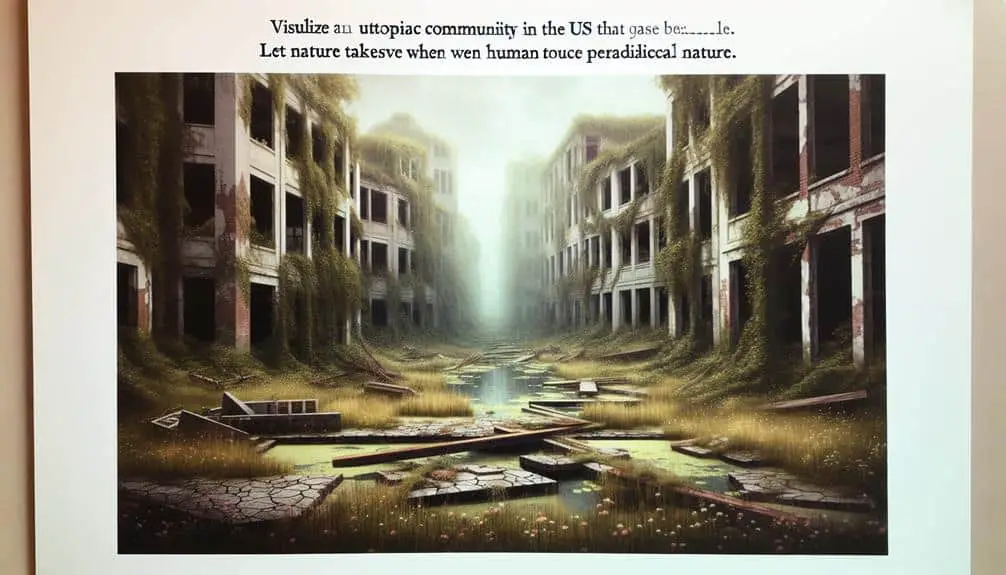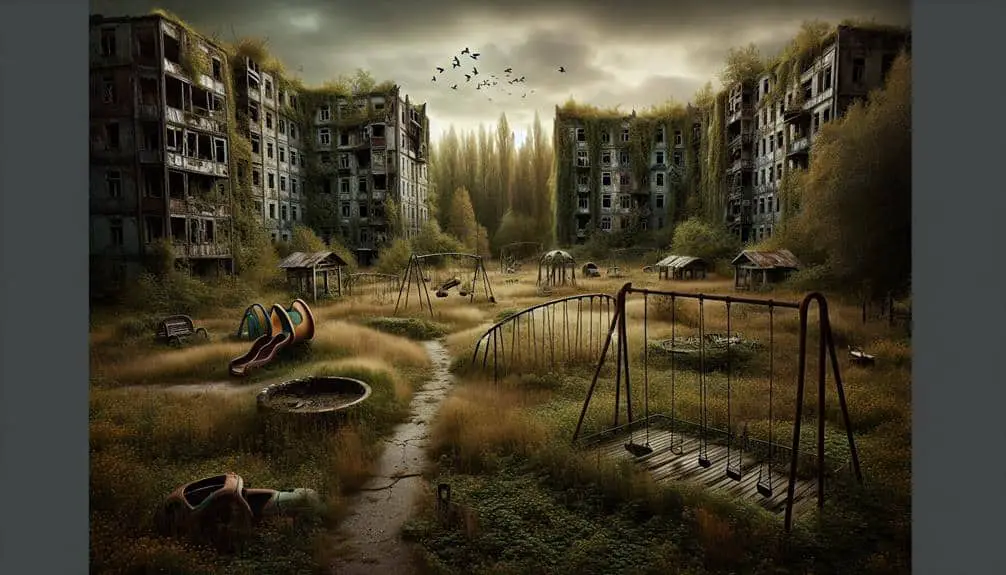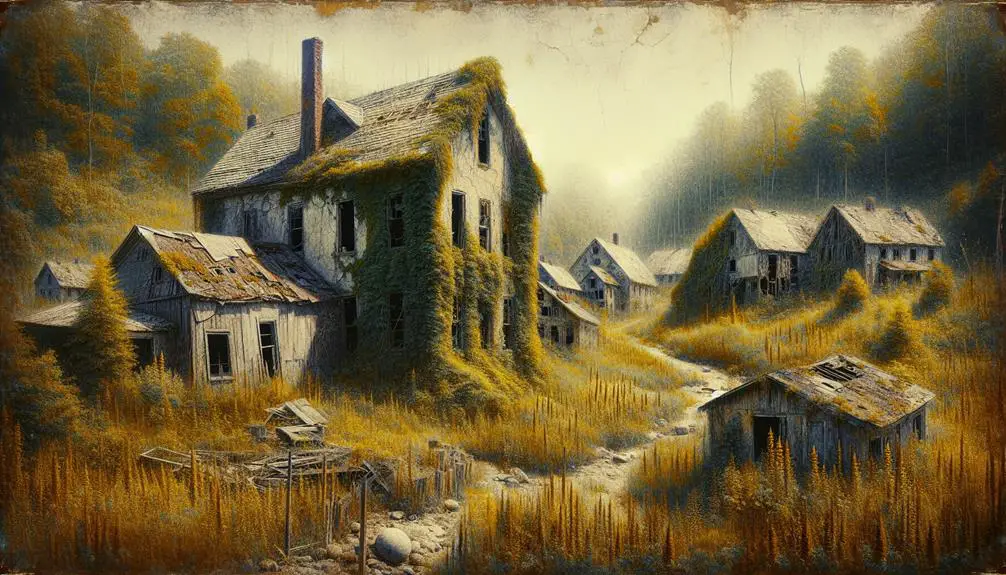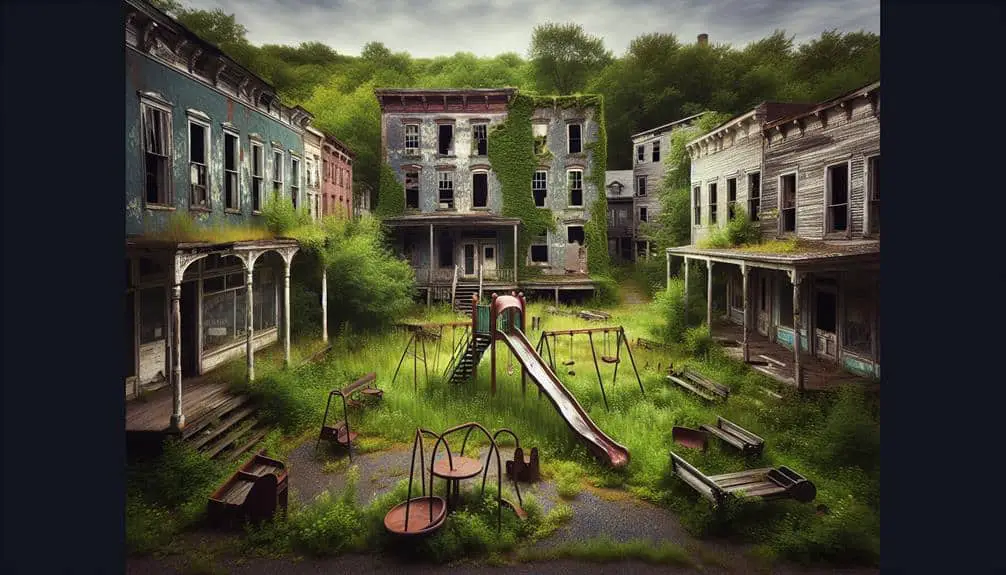Explore the fascinating remnants of abandoned utopian communities in the US. Oneida Community Mansion House embodies communal living ideals with its intricate architecture. Harmony Society Historic District in Pennsylvania showcases communal ownership and religious beliefs. Amana Colonies in Iowa offer insight into a self-sustaining German Pietist community. New Harmony Historic District in Indiana features diverse architectural styles reflecting cooperation and equality. Brook Farm in Massachusetts, founded by George and Sophia Ripley, emphasizes intellectual growth and shared responsibilities. Uncover the intriguing echoes of communal living and idealistic pursuits lingering in these historic sites.
Key Points
- Oneida Community Mansion House founded by John Humphrey Noyes in 1848, emphasizing communal living and complex marriage.
- Harmony Society Historic District in Pennsylvania, established in the early 19th century for religious beliefs and communal ownership.
- Amana Colonies, founded by German Pietists in the mid-19th century, showcasing agricultural lifestyle and communal living in Iowa.
- New Harmony Historic District in Indiana, reflecting principles of equality and cooperation with diverse architectural styles.
- Brook Farm in Massachusetts, founded in 1841 by George and Sophia Ripley, symbolizing communal living, intellectual growth, and cultural activities.
Oneida Community Mansion House
The Oneida Community Mansion House stands as evidence of the unique social experiment that took place in the 19th century. Founded by John Humphrey Noyes in 1848, the Oneida Community aimed to create a utopian lifestyle based on communal living and complex marriage practices. The Mansion House served as the central hub of this community, where members lived, worked, and worshipped together.
Within the walls of the Mansion House, the Oneida Community members endeavored for equality and cooperation, rejecting traditional notions of family and property. They believed in shared responsibility and mutual support, fostering a sense of unity among its residents. The architecture of the Mansion House reflects the communal ideals of the Oneida Community, with shared spaces for dining, meetings, and social gatherings.
Despite facing challenges and controversies, the Oneida Community Mansion House remains a proof of the aspirations and dreams of those who sought to build a better society through collective living. Today, it stands as a reminder of the enduring legacy of communal experiments in American history.
Harmony Society Historic District
Nestled in Pennsylvania, the Harmony Society Historic District showcases the remnants of a once-thriving communal settlement established in the early 19th century. The site, with its historic buildings and picturesque surroundings, offers a glimpse into a bygone era of communal living. The community, founded by Johann Georg Rapp, aimed to create a harmonious society based on religious beliefs and communal ownership.
Today, efforts are underway to revive the spirit of community that once flourished within the Harmony Society. Preservation initiatives have helped maintain the authenticity of the district, preserving its unique architecture and historical significance. Visitors can explore the preserved buildings and imagine what life was like for the members of this utopian community.
Amana Colonies
Among the abandoned utopian communities in the US, the Amana Colonies stand out for their unique history and well-preserved buildings. Established in the mid-19th century by German Pietists seeking religious freedom, the Amana Colonies thrived on an agricultural lifestyle and communal living. Settled in present-day Iowa, these colonies were self-sustaining, with residents working together in farming and crafts to support the community.
The Amana Colonies' architectural integrity remains intact, offering a glimpse into their past. The communal kitchens, craft shops, and residences showcase the simplicity and functionality of their design. Walking through the streets, you can feel the sense of unity and purpose that once flourished in this utopian society.
Visiting the Amana Colonies allows you to immerse yourself in a bygone era of intentional living and shared values. The emphasis on cooperation and mutual support in a picturesque rural setting is a validation of the enduring appeal of communal ideals.
New Harmony Historic District
Explore the rich history and architectural significance of the New Harmony Historic District, a demonstration of utopian ideals in the heart of Indiana. The district showcases a blend of architectural styles ranging from Federal and Greek Revival to Gothic and Classical Revival, reflecting the diverse influences of its past residents. The commitment to architecture preservation is evident in the meticulous restoration efforts that have kept many of the original buildings intact, allowing visitors to step back in time and experience the community's vision firsthand.
The community lifestyle in New Harmony was centered around principles of equality, cooperation, and social experimentation. Residents sought to create a harmonious society where individuals could thrive collectively. The district's layout, with its interconnected buildings and communal spaces, was designed to foster a sense of unity and shared purpose among its inhabitants.
Today, exploring the New Harmony Historic District offers a glimpse into a bygone era of idealism and innovation, where architecture preservation and community lifestyle converged to create a unique and lasting legacy.
Brook Farm
In its pursuit of communal living and intellectual pursuits, Brook Farm emerged as a notable experiment in social reform during the 19th century. Founded in 1841 in West Roxbury, Massachusetts, by George Ripley and Sophia Ripley, this utopian community aimed to create a society where individuals could live cooperatively while engaging in cultural and educational endeavors.
Here's why Brook Farm stands out:
- Communal Living: At Brook Farm, residents shared resources, labor, and responsibilities, fostering a sense of unity and equality among community members. This egalitarian approach to living was a central tenet of the social experiment.
- Intellectual Pursuits: The community placed a strong emphasis on intellectual growth and cultural activities. Residents participated in discussions, lectures, and artistic pursuits, creating a stimulating environment for personal development.
- Legacy of Idealism: Despite its eventual financial struggles and dissolution in 1847, Brook Farm left a lasting legacy as a symbol of idealism and the pursuit of a more equitable society through communal living and shared values.
Frequently Asked Questions
What Led to the Downfall or Abandonment of These Utopian Communities?
When utopian communities faced downfall or abandonment, societal pressures and internal conflicts often clashed with their ideals. Environmental factors and economic struggles further strained their existence, leading to the dissolution of these once-idealistic societies.
Are There Any Ghost Stories or Paranormal Experiences Reported at These Abandoned Utopian Community Remains?
Step into the shadows of abandoned utopian communities, where haunted tales blend with eerie legends. Mysterious happenings and supernatural encounters linger in the crumbling remains, whispering of a past veiled in ghostly mysteries.
How Have Local Communities or Organizations Worked to Preserve and Maintain These Historic Sites?
To preserve these historic sites, local communities and organizations have united in preservation efforts. Through community involvement, they guarantee the maintenance of these places. They also promote their historical significance and offer educational programs.
Are There Any Plans for Future Development or Restoration of These Abandoned Utopian Community Remains?
In the domain of abandoned utopian communities, murmurs of future plans for restoration efforts echo through the forgotten streets. Hope flickers like a distant flame, beckoning you to join the quest for revival.
How Did the Residents of These Communities Sustain Themselves Economically and Socially During Their Time Living in These Utopian Experiments?
To sustain economically, residents engaged in communal farming, shared resources, and sometimes crafts for income. Socially, close-knit relationships, collective decision-making, and shared values fostered cohesion. Economic sustainability and social dynamics intertwined to support their utopian ideals.



